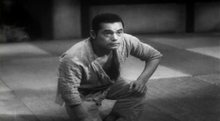Susumu Fujita

Susumu Fujita (藤田 進|Fujita Susumu) (8 January 1912 – 23 March 1991) was a Japanese film and television actor. He played the lead role in Akira Kurosawa's first feature, Sanshiro Sugata, and appeared in other Kurosawa films including The Men Who Tread On the Tiger's Tail (as Togashi, commander of the border guards) and The Hidden Fortress (as General Tadokoro). Later, he was a supporting actor in Ishirō Honda's Mothra vs. Godzilla, among many other films.
Before and during World War II Fujita was considered one of the great stars of Japanese cinema. In the post-war period he became known for supporting roles, often playing a soldier in war films. During the sixties and seventies he played minor roles in "special effects pictures" such as Ultraman and Frankenstein Conquers the World.
Life and career

Fujita was born in Kurume, Fukuoka in Japan. After graduating from high school in 1929 he moved to Tokyo, where he took entrance examinations for several universities, but failed to gain admission. Before returning to Fukuoka he stayed in Kyoto with Takuji Furumi, a film director from his home town. With assistance from Furumi, he secured employment with producer Utaemon Ishikawa as an extra. He was hired as an actor by Toa Cinema in 1931, but did not appear in any films that year. In 1932 he was drafted into military service and enlisted in the 12th Artillery Division. After being discharged from the army in 1934, Fujita went to work for Masahiro Makino's Kyoto Film Recording as an audio engineer. He returned to acting in 1939, when he moved to Toho studios.
At first, Fujita was a contract player appearing in minor roles, but in 1940 he co-starred in Tsuma no baai (妻の場合) with Takako Irie and Minoru Takada; he was praised as a sincere and genuine actor. Beginning in 1941 he played a succession of leading roles, including Shido monogatari (指導物語). In 1943 he appeared in Sanshiro Sugata, the directorial debut of Akira Kurosawa, which brought him to wide popularity. Fujita's popularity as a manly action hero was further cemented with his performance in Kato Hayabusa Sentoutai (加藤隼戦闘隊). He was in the midst of filming The Men Who Tread On the Tiger's Tail when World War II ended.
After the war, Fujita condemned his own portrayal of war heroes and considered leaving acting. However, unable to see himself in any other profession, he returned to the screen. In 1946 he appeared in Kurosawa's first post-war film, No Regrets for Our Youth, about a war-time liberal who was executed for treason.
During a strike at Toho in 1948 Fujita, along with Denjiro Ōkochi, Kazuo Hasegawa and other members of the so-called "Flag ten" secession union broke away to form a new studio, Shintoho (New Toho). This reorganization ended Fujita's collaboration with Kurosawa. At Shintoho, he appeared in several melodramas and action films.
After his contract with Shintoho ended in 1957, Fujita returned to Toho, where he appeared primarily in supporting roles. Fujita and Kurosawa worked together again on The Hidden Fortress in 1958. Although Fujita appeared in a supporting role, it was essential to the film. He appeared in three more Kurosawa films, including Yojimbo, but only in minor roles.
Selected filmography
- Byakuran no Uta (1939)
- Tsuma no baai (1940)
- Kaigun bakugekitai (1940)
- Nessa no chikai (1940)
- Shidō monogatari (1941)
- Hawaii Mare okikaisen (1942)
- Sanshiro Sugata (aka Judo Saga) (1943)
- Kato hayabusa sento-tai (1944)
- Raigekitai shutsudo (1944)
- Sanshiro Sugata Part II (1945)
- Kita no san-nin (1945)
- The Men Who Tread On the Tiger's Tail (1945)
- Minshū no Teki (1946)
- No Regrets for Our Youth (1946)
- A Thousand and One Nights with Toho (1947)
- Jiyuu gakko (1951)
- Avalanche (1952)
- Senkan Yamato (1953)
- Himeyuri no tō (1953)
- Non-chan kumo ni noru (1955)
- Revenge of the Pearl Queen (1956)
- Meiji tennō to Nichiro daisensō (1957)
- Awa odori naruto no kaizoku (1957)
- The Mysterians (1957)
- The Hidden Fortress (1958)
- Watashi wa kai ni naritai (1959)
- Submarine I-57 Will Not Surrender (1959)
- Storm Over the Pacific (1960)
- The Bad Sleep Well (1960)
- The Story of Osaka Castle (1961) as Katsuyasu Sakakibara[1]
- Yojimbo (1961)
- Chushingura: 47 Samurai (1962)
- Attack Squadron! (1963)
- High and Low (aka The Ransom) (1963)
- Chintao yosai bakugeki meirei (aka Siege of Fort Bismarck) (1963)
- Atragon (1963)
- Kokusai himitsu keisatsu (1964)
- Kyo mo ware ozora ni ari (1964)
- Mothra vs. Godzilla (1964)
- Dagora the Space Monster (1964) as General Iwasa[2]
- Horafuki taikoki (1964)
- Samurai Assassin (1965)
- Kiga Kaikyo (1965)
- Taiheiyo kiseki no sakusen Kisuka (1965)
- Frankenstein Conquers the World (1965)
- Nihon no ichiban nagai hi (1967)
- Ultraman (1967)
- Rengo kantai shirei chōkan Yamamoto Isoroku (1968)
- Nihonkai daikaisen (1969)
- Tora! Tora! Tora! (1970)
- Shiosai (1971)
- Seishun no mon (1975)
- Fuyu no hana (1978)
- Ultraman: Great Monster Decisive Battle (1979)
- Rengō kantai (lit. "Combined Fleet", released in the U.S. as The Imperial Navy), (1981)
- Detective Story (1983)
References
- ↑ Stuart Galbraith IV (16 May 2008). The Toho Studios Story: A History and Complete Filmography. Scarecrow Press. p. 177. ISBN 978-1-4616-7374-3.
- ↑ Stuart Galbraith IV (16 May 2008). The Toho Studios Story: A History and Complete Filmography. Scarecrow Press. pp. 212–213. ISBN 978-1-4616-7374-3.
External links
| Wikimedia Commons has media related to Susumu Fujita. |
- Susumu Fujita at the Internet Movie Database
- Susumu Fujita at the Japanese Movie Database (Japanese)